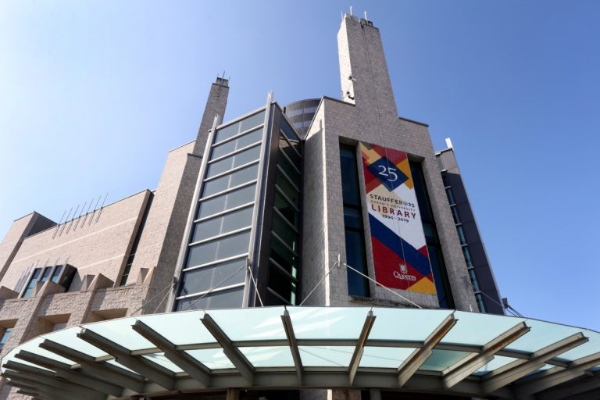Stauffer Library marks 25th anniversary
October 22, 2019
Share

One of Queen’s University’s most recognizable landmarks turns 25 this year. The Joseph S. Stauffer Library at the corner of Union Street and University Avenue opened in 1994 and has since served as a crucial gathering place dedicated to intellectual discovery, creative exploration, and knowledge exchange, right in the heart of campus.
The five-storey building is the university’s largest library, built with room for approximately 1.5 million volumes, six kilometres of book stacks, and study and research space for more than 1,200 students. Its construction was supported by a $10-million contribution from the Stauffer Foundation, and its design went on to win the Governor General’s Award for Architecture in 1997, for its outstanding contribution to Canadian architecture.
“Stauffer is a beautiful space with exceptional collections and services housed inside, where students, faculty, and staff, along with the greater community, engage in the shared experience of learning,” says Michael Vandenburg, Interim Vice-Provost and University Librarian. “It is also where we can see firsthand the shifting nature of libraries in the digital age, and how our users are changing the ways in which they access materials and benefit from library spaces.”
From the outset, Stauffer’s first chief librarian Paul Wiens called the space the “centrepiece for library renewal,” adding that its mandate would seek to link the print and electronic dimensions of the information universe. Since then, the library has sought to keep in step with its users’ rapidly changing demands.
In addition to its physical collections, Stauffer Library and its counterparts on campus have steadily pushed forward on emerging technologies, providing early access to databases of information resources through a network of CD-ROMs and moving quickly to introduce access to scholarly resources via the internet. The early years of Stauffer also saw the introduction of scholarly publishing services through the QSpace institutional repository and the creation of the Queen’s Learning Commons.
Later, under the leadership of Martha Whitehead, who served as Vice-Provost (Digital Planning) and University Librarian from 2011-2019 (before becoming Vice-President of Harvard Library), the Queen’s University Library seized new opportunities to move into the digital age while building on traditional library values. Her work enabled new services for research data management, copyright guidance, and support for digital scholarship and open education resources.
Queen’s University Library continues to enhance Stauffer’s physical spaces as well.
Stauffer Library has been, and continues to be, a place where everyone belongs and should feel included. In its first year, the Canadian Association of College and University Libraries recognized Stauffer’s Adaptive Technology Centre (ATC) with an innovation achievement award for its leadership in serving students with disabilities by providing accessible spaces, course materials in alternate formats, and specialized technologies.
Fast-forward through the years and we see Stauffer Library add a prayer and meditation room, a movement space to promote fitness, and Indigenous-named study rooms created to advance the university’s efforts at reconciliation.
Indigenous visibility and decolonization at the library
To celebrate the library’s 25th year, the Stauffer Foundation has contributed a new gift of $500,000 to raise the presence of Indigenous voices and culture in the space even more. The funding will be used for the creation of an Indigenous Learning Space in Stauffer’s lower level, slated to open in spring 2020. The space is envisioned as being welcoming to Indigenous students and faculty, while at the same time enriching the learning of non-Indigenous library patrons.
“This anniversary has given us the chance to reflect on the past 25 years at Stauffer and, thanks to the funding from the Stauffer Foundation, to prioritize Indigenous spaces and voices,” says Heather McMullen, Associate University Librarian and Stauffer@25 project lead.
The funding will also go toward creating additional Indigenous-named study rooms in other library locations on campus, and toward supporting a speaker series during the anniversary year. Indigenous journalist and activist Tanya Talaga will speak at the series’ first event on Nov. 26.
Moving ahead, the library will continue to evolve as an important gathering place, not only a place where ideas are explored, concepts are learned, and theories are unearthed, but where friends are met, relationships are forged, and a vibrant, inclusive, and growing community thrives in an ever-changing world.
Learn more about Stauffer@25 anniversary celebrations and explore all of the services Queen’s University Library has to offer on the website.